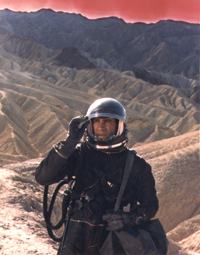

USA science fiction
1964
color 110 min.
Director: Byron Haskin
CAV: out-of-print collectible
2 discs, catalog # CC1336L
 Untitled Document
Untitled Document
Robinson Crusoe on Mars is exactly what its title implies: a science
fiction vision of Daniel Defoe's classic novel. Only one man liked the title.
Ib Melchior ed it for his 1961 screenplay, but it was just a working title.
By the time Byron Haskin, the director, came on board three years later,
he wanted to change it too. But to producer Aubrey Schenk it was the title
that sold the film -- to Paramount and the public.
Defoe's novel is, among other things, an adventure in colonialism with
Crusoe representing the Protestant capitalist adventurer, the hero who travels
to foreign shores and makes them home, the great conqueror who meets the
savage tames and converts him. These elements are all very much evident
in the film. sci-fi twist forces a few changes, however. Instead of being
wrecked on a desert island, our hero, Christopher "Kit" Draper
is wrecked on Mars. His animal companion is a monkey instead of a parrot.
And the Friday he eventually meets is slave of mysterious beings from some
other planet, rather then the near-dinner of his fellow cannibals.
Director Byron Haskin modestly denies any claim to the title "auteur"
(though word fits in its literal sense given his hand in rewriting several
screenplays and penchant for revising scenes the night before he
filmed them). The film was, to a large degree, a group effort. Ib Melchior,
who wrote the script, was going to direct the film but ended up directing
his script of The Time Travellers.
Following Haskin's divestiture, perhaps we should consider these films
less as the expression of Haskin's vision than of their historical moment
-- the fate '50s and early '60s, when "our side" was adventurous,
individualistic, and benign, while "their side" was a nightmare
of totalitorian evil.
It is common to read '50s science fiction films as allegories of the
Cold War. Invasion of the Body Snatchers (1956), with
its Americans being turned one by one into emotionless pod people is only
one of many examples. In an interview, Haskin himself connects the
Martian invaders in his earlier film, War of the Worlds, with the
Russians. At the film"s climax, when God, in answer to the prayers
of a churchful of Los Angelenos, kills the invaders with a disease to which
they are not imune, we learn that, although bacteria are God's creatures,
Martians are not. In Robinson Crusoe on Mars, the evil spacemen,
in ships resembling those in War of Worlds, have enslaved the people
of Friday's planet (who look rather like extras from The Ten Commandments).
But the focus has changed between 1951 and 1964, perhaps in response
to growing knowledge of outer space. From H.G. Wells' day to the '50s, men
from Mars had been the stereotypical villains of science fiction, personifying
a fear of the unknown. By the mid-'60s, we knew that there were no such
men. In fact, we were pretty sure that as intelligent life forms, we were
alone in our solar system. The evolution of the science fiction film parallels
this recognition.
The genre also reflects the changing relationship to Russia. The films
of the '50s emphasized invasions and battles that were thin disguises for
the war against communism. Robinson Crusoe on Mars, however, represents
a Kennedy-era turning away from that paranoia toward a future based on successful
technology. Indeed, the film's production history charts a hybrid venture
based on the specifics of technology. Ib Melchior's three-hour screenplay
features a "technically correct" Martian landscape, except for
the fact that it is populated by incredible beasts. Like other Melchior
projects, Robinson Crusoe on Mars features a high-tech high concept
driven by a classic tale about survival against the odds.
Haskin took the screenplay and had it refashioned by screenwriter John
Higgins, with the fantastic elements deleted at Haskin's request. "It
must be scientifically accurate," Haskin would decree. Melchior had
been inspired in the first place by Death Valley, and he even submitted
photographs of potential locotions with his screenplay. Death Valley is
where Haskin and his crew ended up. Haskin's background as a cinematographer
in the '20s and head of the Warners Special Effects Department in the '30s
served him well. The desert setting is a beautiful but forbiddingly vast
and empty space. All that sand, especially filmed in the widescreen Techniscope
process, dwarfs Kit Draper in a convincingly alien environment. And perhaps
as much as anything else, the theme of the film is loneliness. With God's
help and American ingenuity, our hero can find oxygen, food, water, and
shelter; his biggest problem, however, is facing life entirely alone.
--John Peavoy
CAST & CREDITS
Executive Producer ... Edwin F. Zobel
Producer ... Aubrey Schenk
Director ... Byron Haskin
Screenplay ... Ib Melchior & John C. Higgins
Cinematogropher ... Winton C. Hoch
Color Consultant .. Richord Mueller
Art Direction ... Hal Pereira & Arthur Lonergan
Eilm Fditor ... Terry 0 Morse
Music ... Nathan van Cleave
Sound ... Harold Lewis & John Wilkinson
Assistant Director ... Arthur Jacobs & Robert Goodstein
Makeup ... Wally Westmore & Bud Bashaw
Special Photographic effects ... Lawrence W. Butler (BUTLER-Glouner Inc.)
Process Photography ... Farciot Edouart
Technical Adviser ... Edward V. Ashburn
Commander Christopher "Kit" Draper ... Paul Mantee
Friday ... Victor Lundin
Colonel Dan McReady ... Adam West
Mona Barney, the Wooly Monkey
An Aubrey Schenk-Edwin F Zabel (Devonshire/ Paramount) Producton.
Technicolor & Techniscope Based on the novel by Daniel Defoe.
ABOUT THE TRANSFER
This exclusive digital transfer was made from a 35mm duplicate negative,
struck from the original 35mm Techniscope intermediate positive, and the
original 35mm three track mono magnetic track. This film is presented in
its original aspect ratio of 2.35:1.




